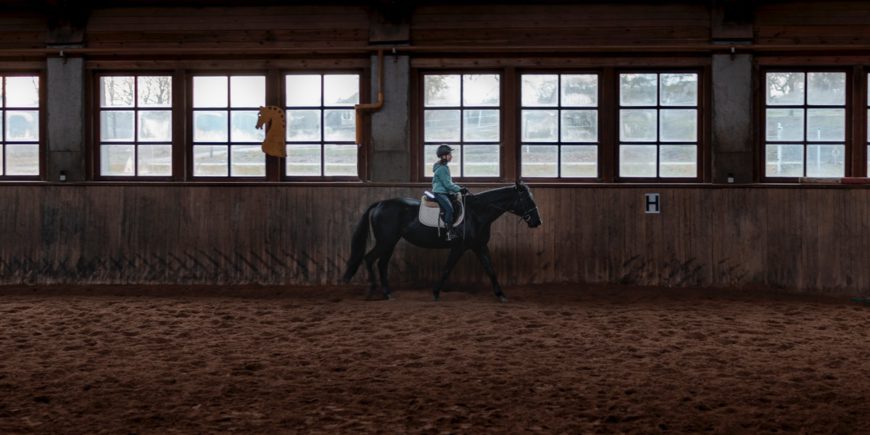Many companies will have experience in equine arena surfaces, and they will be able to guide you through this process. It is best to test contractors out on your horse arena, giving them a little project to complete for you before you commit to a more significant project like building a horse arena. Of course, hiring a builder that is also an equestrian makes a big difference as well, as they have the instincts of knowing how a horse would respond to certain aspects of the arena’s design that somebody not knowledgeable about horses would not. When it comes to sand, you will need to speak to the company that processes it. They should have intimate knowledge about what products of theirs are used successfully in the equestrian arena.
The arena footing material you select needs to fit the local setting and the horse disciplines. Before even considering choosing arena footing, you need to be 100% confident about the foundation of your equine arena. No matter what the footing, your riding arena is only as good as the foundational integrity supporting it.
The job of a suitable base is to create an even surface that supports the feet on top. The footing materials are just the uppermost layer in constructing an indoor arena, and they depend on support from the proper foundation and under the foundation. The footing needs to knit into the base material, meaning that loose footing is not allowed to slide freely over the base material while horses are working in an arena. It is this upper layer that you want to provide the horses with grip and cushioning, which is what makes an arena pleasant to work in.

The cake layer represents the foundation of your arena. The frosting is the top layer of your footing. Once you have finished work, your focus becomes on keeping your top layer free and spread evenly across your entire arena surface. Instead, you want your arena to have a solid, sturdy bottom layer about half-a-foot deep and the top layers between 2.5 inches and 3 inches thick, depending on your preferences and what events you are interested in hosting.
For the 100mm thick minimum layer, you would need 80 cubic metres, or almost seven truckloads, to cover your arena. You might not think that much ground is being disturbed, but you will be shocked by double the amount of soil compared to the size of your arena. Be sure the increases are not interfering with arena drainage. Otherwise, all of your hard work will be for naught.
It would be best if you allowed drainage below the tie bars; otherwise, your arena will be saturated when it rains. Too much water will fill your arena, making it impractical to operate in the long run. Without adequate drainage, you might even find that your DIY arena is submerged in water, making it unusable most of the time. If you are building an indoor arena, you will not have any natural water to work with, which could be both a blessing and a curse.
Any water that gets underneath your arena weakens the arena’s structure, so you will want to keep the water moving around it. The last thing you want is for the water to be gathered on the edge of your arena due to edges forming barriers since this area is usually used most.
It will get drier if you only run your arena weekly, or maybe monthly, and are not regular with the watering. The amount of dust in your arena will affect the health of horses and riders, as well as anyone else using the arena. Also, the extent to which you take care of dust management, particularly in indoor arenas, will directly affect the health of your horses, yourself, and others who use the arena as well, not only riders and trainers but spectators, assistants, and others.
While the initial build is crucial, the ongoing care of your arena is equally essential in keeping both your horse and riders safe and happy. No matter who built your arena, correct maintenance is critical to its long-term viability.
Without a good foundation and correct footing, it is hard to keep going consistently enough for the horse’s health and safety. Depending on your chosen riding discipline, your arena should offer stable, safe feet, which allow your horse to move in and out of motion. Decisions regarding footing for your riding arena are much more complex than one would imagine. With no universal prescription for a successful surface material for an equine arena, understanding the physics you are trying to accomplish with the footing may result in a better selection of materials.
Extreme care must be taken in using arena tools on your footing to keep your compound consistent and structured. Regardless of the type, most arena surfaces will require resurfacing at least every two years, as arena footing materials will not last forever. Arena footings that satisfy these three essential requirements may consist of different materials — both natural and synthetic — and combinations of foot types. From Western Pleasures to Speed Events, a versatile arena needs safe, long-lasting footing that holds up while not being too deep or slippery.
If you have tried training on shoddy terrain, or your arena has been neglected for some time, it might take some work by professionals to bring the surface up to that level. The riding character is essential to be adequately maintained to keep your horses safe, as well as your arena’s lifespan.




